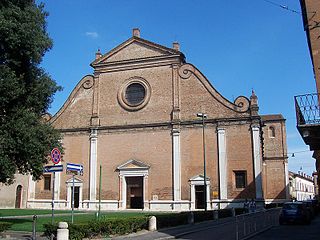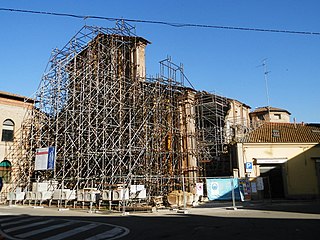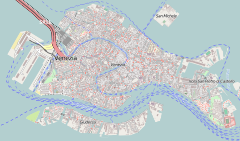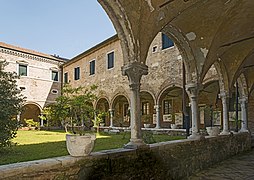
The Patriarchal Cathedral Basilica of Saint Mark, commonly known as St Mark's Basilica, is the cathedral church of the Patriarchate of Venice; it became the episcopal seat of the Patriarch of Venice in 1807, replacing the earlier cathedral of San Pietro di Castello. It is dedicated to and holds the relics of Saint Mark the Evangelist, the patron saint of the city.

The Basilica di Santa Maria Gloriosa dei Frari, commonly abbreviated to the Frari, is a church located in the Campo dei Frari at the heart of the San Polo district of Venice, Italy. It is the largest church in the city and it has the status of a minor basilica. The church is dedicated to the Assumption of Mary.

Mazzorbo is one of various islands in the northern part of the Lagoon of Venice. Like the other islands in this part of the lagoon, it was the site of one of the earliest settlements in the lagoon which predated the development of Venice. However, these islands then declined and were eventually abandoned. In the 1980s the architect Giancarlo De Carlo built a brightly coloured residential neighbourhood to help to repopulate Mazzorbo. In 2019 its population was 256. It is linked to Burano by a wooden bridge. It was once an important trading centre but is now known for its vineyards and orchards. Its main attraction is the fourteenth century church of Santa Caterina.

The Convent of Christ is a former Catholic convent in Tomar, Portugal. Originally a 12th-century Templar stronghold, when the order was dissolved in the 14th century the Portuguese branch was turned into the Knights of the Order of Christ, that later supported Portugal's maritime discoveries of the 15th century. The convent and castle complex are a historic and cultural monument and was listed as a UNESCO World Heritage site in 1983.

San Michele in Isola is a Roman Catholic church, located on the Isola di San Michele, a small islet sited between Venice and Murano, which once sheltered a Camaldolese monastery, but now houses the main cemetery of the city. The monastery was mostly demolished in the 19th century, but the church remains, originally rebuilt starting in 1469. The church is dedicated to Saint Michael, the holder of the scales on Judgement Day, a fit guardian of the sleep of the faithful dead. The island cemetery now includes the land of the formerly separate island of San Cristoforo. This church is sometimes referred to as San Michele di Murano, although this islet is separate from islands comprising that town.

San Giorgio Maggiore is a 16th-century Benedictine church on the island of the same name in Venice, northern Italy, designed by Andrea Palladio, and built between 1566 and 1610. The church is a basilica in the classical Renaissance style and its brilliant white marble gleams above the blue water of the lagoon opposite the Piazzetta di San Marco and forms the focal point of the view from every part of the Riva degli Schiavoni.

San Francesco della Vigna is a Roman Catholic church in the Sestiere of Castello in Venice, northern Italy.

San Nicolò al Lido refers to both the San Nicolò Church and most importantly to its annexed Monastery of San Nicolò located in Venice, northern Italy. The two Catholic institutions are located in the northern part of the Lido di Venezia and house the relics of Saint Nicholas, patron of sailors. From this church, the traditional thanksgiving Mass of the Sposalizio del Mare is celebrated. The complex houses monks of the Franciscan order.

The Church of St Job is a 15th-century Roman Catholic church located overlooking the campo of the same name, known as Sant'Agiopo in Venetian dialect, on the south bank of the Cannaregio canal near Ponte dei Tre Archi in the sestiere of Cannaregio of Venice, northern Italy,

San Bernardino is a church in Verona, northern Italy. The church, in Gothic style, was built from 1451 to 1466.

The church of Santa Maria Assunta, known as I Gesuiti, is a religious building in Venice, Italy. It is located in the sestiere of Cannaregio, in Campo dei Gesuiti, not far from the Fondamenta Nuove.

The Abbey of Santa Giustina is a 10th-century Benedictine abbey complex located in front of the Prato della Valle in central Padua, region of Veneto, Italy. Adjacent to the former monastery is the basilica church of Santa Giustina, initially built in the 6th century, but whose present form derives from a 17th-century reconstruction.

San Procolo is an early Gothic-style, Roman Catholic church and former monastery-hospital located on Via Massimo D'Azeglio #52 in central Bologna, region of Emilia Romagna, Italy.

San Lio is a church located on the campo of the same name in the sestiere of Castello.

San Francesco is a late-Renaissance, Roman Catholic minor basilica church located on via Terranuova in Ferrara, Emilia-Romagna, Italy.

The Certosa di Pontignano, also known as the Certosa di San Pietro, is a Carthusian monastery and church in the neighborhood of Pontignano, within the town limits of Castelnuovo Berardenga, a few kilometers north of the city of Siena, in the region of Tuscany, Italy. The monastic complex, after the expulsion of the monks in 1810, passed through various hands, until it was acquired in 1959 by the University of Siena, and used for academic meetings, conventions, and also hotel and restaurant for events such as weddings and celebrations.

Ognissanti is a 16th-century Roman Catholic church located in the Dorsoduro sestiere of the Italian city of Venice.

San Geminiano was a Roman Catholic church located in Piazza San Marco in Venice, Italy, dedicated to Saint Geminianus. It is believed to have been founded by the Byzantines in the 6th century AD and it was destroyed and rebuilt several times over subsequent centuries. The last reconstruction began in 1505 to designs of the architect Cristoforo da Legname, and it was completed by Jacopo Sansovino in 1557. This church was a significant example of Venetian Renaissance architecture, and it was well-known for being ornate and richly decorated. The building was demolished in 1807 in order to make way for the Napoleonic wing of the Procuratie, and many of the artworks it contained were distributed among other churches and museums.

The church of San Francesco is a church located in Mirandola, in the province of Modena, Italy.

Santa Maria della Verità is a Roman Catholic church in Viterbo, region of Lazio, Italy. Formerly a monastic church and sanctuary, the adjacent convent has now been converted into the Civic Museum while the church is now a parish church.





























